The best varieties of edible honeysuckle
Tundra, Blue Dessert, Assol, Ussulga are delicious, healthy and unpretentious varieties of honeysuckle. They are grown in the southern and northern regions of Russia, the plants are immune, most bear fruit already 3-4 years after planting. Early varieties ripen in early June, late ones - closer to July. The culture is resistant to shattering of fruits; liqueurs, preserves, confitures and other sweets are prepared from berries.
Consider a description of the best varieties of edible honeysuckle, the features of their cultivation and use.
The content of the article
Edible honeysuckle varieties
An overview of popular varieties contains information about the ripening time, commercial qualities and taste, yield. A description of the different honeysuckle crops will help gardeners make the right choice.
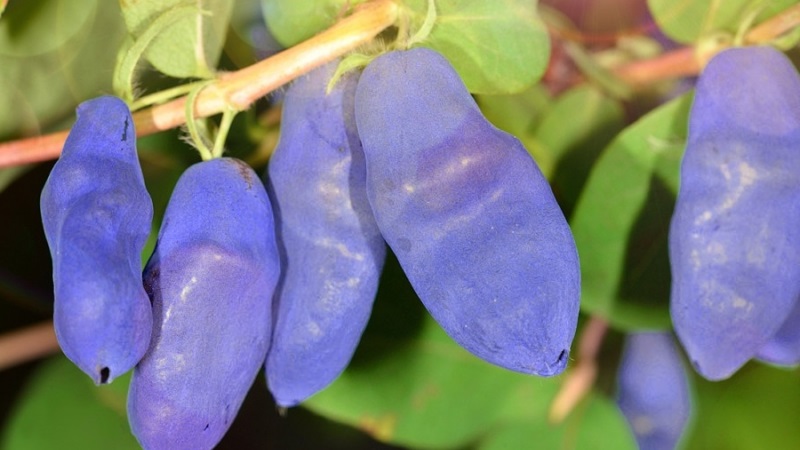
Blue dessert
Medium early honeysuckle, harvest after 15 June. Bushes are medium-sized, erect shoots are brown-red. The berries are blue and have a thin bluish bloom. The shape is drop-shaped, the average weight is 0.8 g. The skin is thin, the pulp is juicy and aromatic, the taste is sweet and sour. Tasting score - 5 points. The berries do not crumble, they are suitable for fresh consumption and processing.
Bell
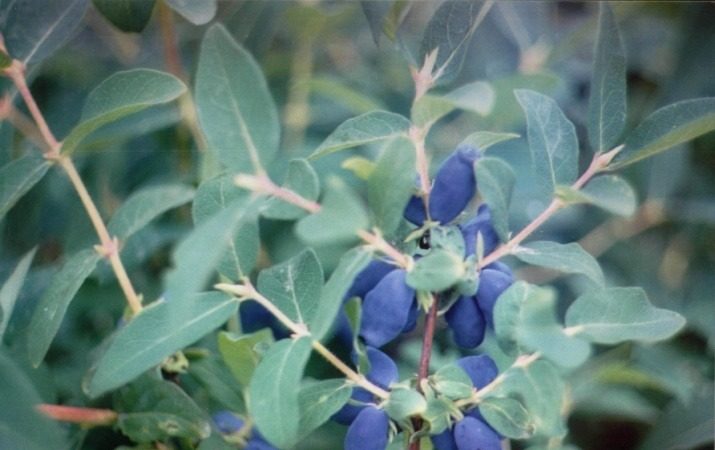
The variety is early maturing, versatile in use. Vigorous bushes, up to 1.8 m high, require a spacious planting space. Leaves are large, dark green. The berries are bell-shaped, blue-blue lumpy. They weigh about 0.8 g, the skin is thin. The taste is sweet and sour, without bitterness. Productivity - up to 2 kg per bush over the summer. Of the advantages of the Honeysuckle Bell, winter hardiness and strong immunity are noted.
Boreal Beauty
Delicious and sweet variety of Canadian selection. The bushes are short and compact, the shoots are strong, do not bend under the weight of the fruit. The average weight of oblong oval berries is 2 g, the pulp is dense and juicy. Honeysuckle does not crumble, suitable for manual and mechanized harvesting. Boreal Beauty ripens in late July or early August, fruiting is extended.
Tundra
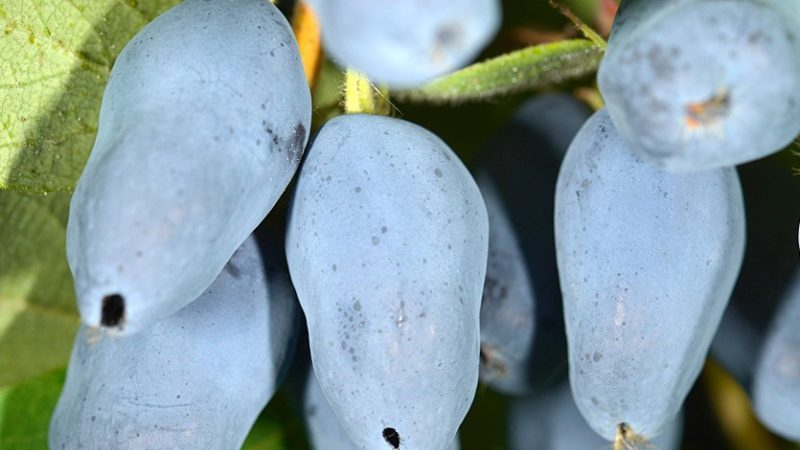
Bushes are wide-growing, spreading, up to 130 cm high. Fruits are elongated oval, weigh about 1.2 g. Slightly tuberous, colored blue-violet, covered with a waxy coating. The taste is sweet and sour; when the soil is waterlogged, the acid increases. Honeysuckle Tundra is a frost-resistant and unpretentious cultivar in cultivation. Jams and jams, juices and tinctures are prepared from berries. Some summer residents freeze fruits for the winter.
Zinri
Zinri's honeysuckle comes from Belarus, ripening period is medium early. Summer residents appreciate it for its large and sweet fruits: the weight is about 1 g, the shape is oval-cylindrical, the pulp is sweet and fleshy. Zinri has a pleasant aroma, does not taste bitter. Productivity - up to 2.3 kg per plant, high winter hardiness. The plant is not damaged by aphids and wasps, disease resistant. Bushes are upright, up to 1.5 m high, strong shoots.
Attention! Most of the bushes are self-fertile, so experienced gardeners recommend growing 2-3 different varieties on the site. This will ensure cross-pollination and increase yields.
Boreal Best
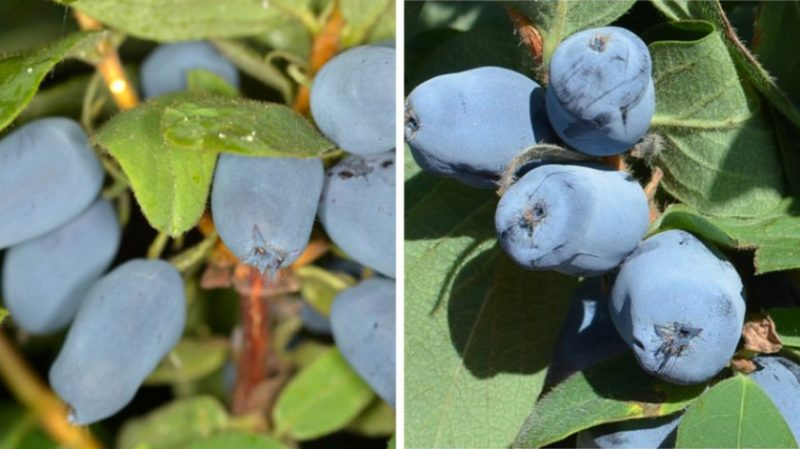
Late-ripening dessert variety, harvest in late July or early August. The bushes are medium-sized, the leaves are light green small. The berries are large, oval in shape, blue-blue color. The pulp is tender and juicy, the tasting score is 4.5 points. The berries do not crumble, the harvest is used for transportation, storage and processing.One plant produces up to 4 kg of delicious honeysuckle per summer.
Bogatyr
The bushes are medium-sized, up to 1.8 m high, the crown is round. The berries are large, one reaches 3 g, the shape is pear-shaped and elongated. The color is violet-black, with a waxy bloom, the skin is of medium thickness. Harmonious sweet taste, tasting score - 4.8 points. Bogatyr's honeysuckle is unpretentious in cultivation, quickly adapts to climatic conditions, reacts favorably to mineral and organic fertilizers.
Delicacy
The plant is compact, up to 1 m high, the crown is round. Small shrubs fit into small garden areas. The berries are blue and smooth, the average weight is 0.8 g. The pulp is firm sweet-sour, no bitterness. Fruiting occurs in June-July, the bush gives up to 1.5 kg of berries. Honeysuckle Delicacy is eaten fresh or used in cooking: fruits are added to baked goods, desserts, drinks, sauces.
Read also:
Fire opal
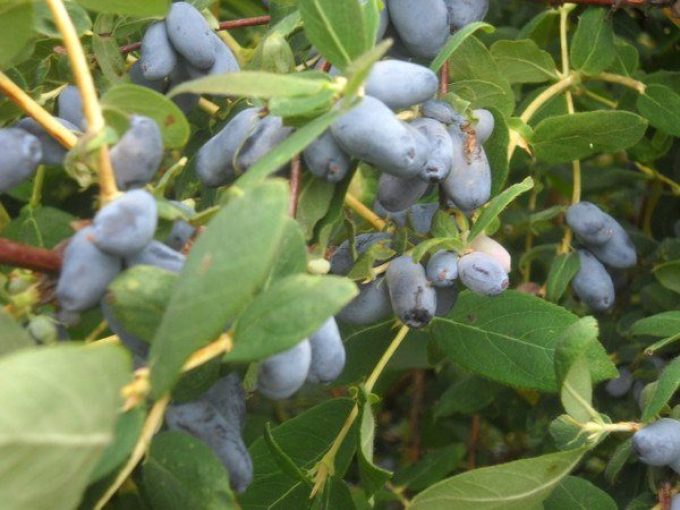
Unopussed shoots are dark green, the height of the bush is average. Fire Opal ripens in July, fruiting continues until August. The berries are blue-blue, weigh about 1.2 g, with a waxy bloom. The taste is balanced sweet and sour, no bitterness. Honeysuckle is valued for its immunity to powdery mildew, unpretentious cultivation and frost resistance.
Narymskaya
Narym dessert honeysuckle, universal in use. Ripens early, compact bushes, slightly pubescent shoots. The berries are violet-blue, with a blue bloom, weigh about 0.9 g, the peel is dense. The taste is sweet and sour, the tasting score is 4.8 points. The plant blooms in mid-May. The yield of the variety is up to 2 kg of berries from a bush. The fruits are suitable for all types of processing.
Attention! The sourness in the pulp of honeysuckle appears due to over-watering. It is not recommended to overmoisten the culture, especially if the summer is rainy. Water the plant no more than 1 time in 2-3 weeks.
Star
Large-fruited variety, berry weight - up to 2.8 g. Fruit shape is oval, blue-violet color, with a bluish bloom. Asterisk bears fruit in June; shedding is weak. The taste is sweet and sour, with a bright blueberry aroma. The pulp is juicy and soft, pleasant. Bushes are straight and branched, up to 2 m high. The variety is resistant to rot and powdery mildew, self-pollinated.
Persistent
An unpretentious variety is common in the middle zone of the country and in the northern regions. Honeysuckle got its name due to its frost resistance and unpretentiousness. Ripening period is late. The plant is tall, spreading, purple dull shoots. The berry weighs about 0.8 g, the shape is oval, the surface is bumpy. The color is blue, with a waxy coating. The taste is sweet and sour, with a slight bitterness, tasting score - 4.2 points. The crop is resistant to spotting and rot.
My joy
Ripening period is medium late. The plant is medium-sized, with straight dull pinkish shoots. The purpose of the honeysuckle is dessert: the berries are eaten fresh or sent for processing. The berries are round-oval, dark blue, with a waxy coating, weighing about 1 g. The taste is delicate, no bitterness. The aroma is weak. Ripe berries do not crumble, do not lose their marketable qualities and taste. The yield of the variety per season is about 2.3 kg per bush.
Pushkinskaya
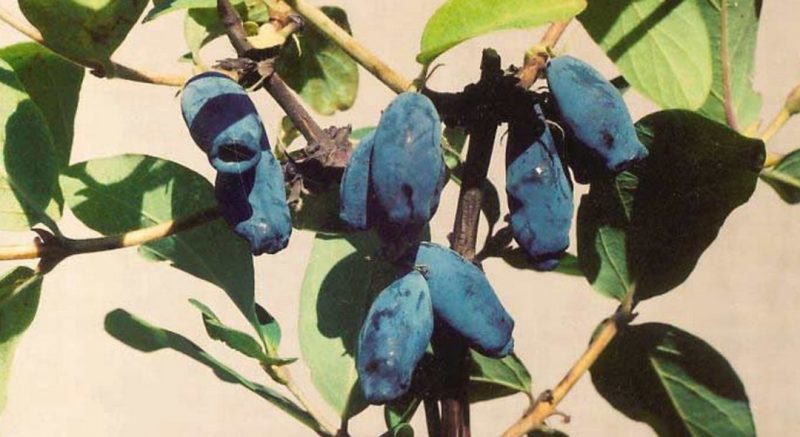
Pushkinskaya frost-resistant, withstands frosts down to -27 ° C. Shoots grow quickly, medium spreading, flat-round crown. Early ripe dessert variety. The berries are cylindrical in shape and blue-violet in color, the skin is thin, with a waxy bloom, the surface is slightly hilly. The average weight of the fruit is 1 g. The aroma is sweet, the pulp is tasty, the tasting score is 4.4 points. Harvested by mid-June, the fruits are easily detached from the stalk.
Assol
The bushes are medium-sized and medium-sized, the shoots are opaque, non-pubescent. Assol is appreciated for its early maturity, early ripening, and unpretentiousness. The berries are dark purple, with a waxy coating, weighing 1.1 g. The taste is sweet-sour and aromatic, the tasting score is 5 points.Assol's honeysuckle is not affected by apical aphids, goldsweet and scutellus.
Attention! To strengthen the immune system, plants are sprayed with a mixture of potassium permanganate and wood ash. Such feeding will protect against diseases and accelerate the development of fruits. 2-3 procedures are carried out over the summer.
Zoya

The bushes are vigorous, the crown is oval, the shoots are matt. The leaves are concave dark green. The fruits are oval, with a slightly hilly surface, weighing about 1 g. The color is blue, with a waxy bloom. The taste is simple, with tart notes. Zoika is undemanding to growing conditions, withstands temperatures up to -40 ° C. To obtain a rich harvest, it is recommended to plant other pollinating varieties nearby.
Kingfisher
Dessert variety of medium late ripening. Bushes vigorous and compressed, yellow flowers. The berries are large, oval, with a thick tip. The color is dark blue, with a blue bloom, there is a slight pubescence. The taste is refreshing and aromatic, there is no bitterness. Berry weight - 1.1 g, yield - up to 2 kg per bush. Kingfisher's score is 4.8 points.
Princess
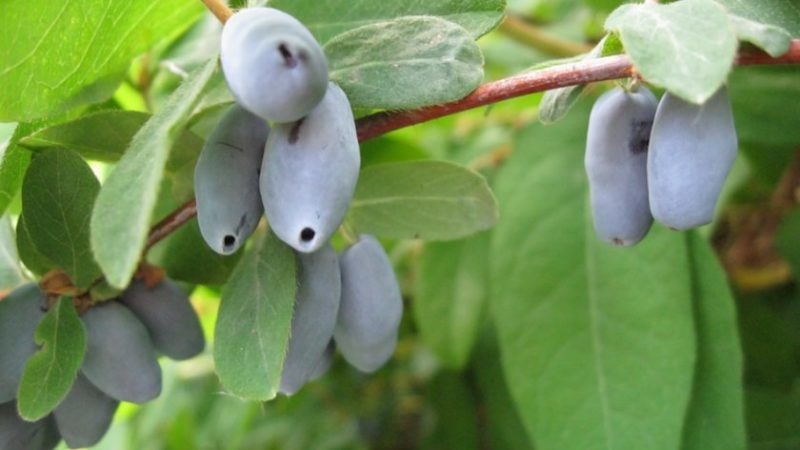
An unpretentious cultivar with a medium early ripening period. The berries are oval blue-blue. Weight - up to 1.8 g, sweet and harmonious taste, juicy pulp. The Princess bears fruit for 3 years after planting, up to 3 kg of harvest is harvested from the bush. In addition to tasty and healthy berries, the variety has a decorative appearance - the plant is planted along the fence or next to summer cottages.
Ussulga
The ripening period is medium early, the purpose is universal. Shoots are straight and dull, strongly pubescent. The berries are oblong-oval, weigh from 1.3 g to 1.5 g. The color is dark purple, with a waxy bloom. The skin is thin, but firm, without pubescence. Ussulga is resistant to shattering and cracking of berries. The taste is sweet, without bitterness, tasting score - 5 points. Honeysuckle is not affected by diseases and pests, it quickly adapts to any climatic conditions.
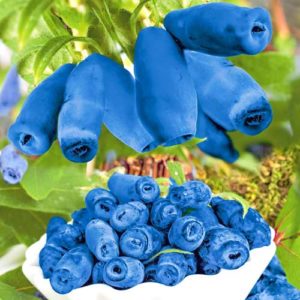
Blue Velvet
Attractive and beautiful honeysuckle. The ripening period is medium late, the plant is undemanding to growing conditions. Fruits are oblong-oval, 3 cm long, with an average weight of 1.2 g. The skin is thin, the flesh is juicy, the taste is sweet and sour, not bitter. The fruits stay on the bushes for a long time, do not crumble. Plants are compact, with a neat oval crown. Jam and jams, honeysuckle juices and compotes are made from berries. The dishes are not only tasty, but also healthy.
Souvenir
Mid-season honeysuckle Souvenir is grown in all regions of the country. The bushes are medium-sized, with an oval and dense crown. Leaves are medium dark green. The berries are large, oval-elongated, blue. Weight - about 1 g, thin skin. The taste is pleasant, the aroma is average, the tasting score is 4.7 points. Winter hardiness and drought resistance are high, the variety is not damaged by pests. Flowering occurs in May, regardless of weather conditions.
Inedible species and varieties
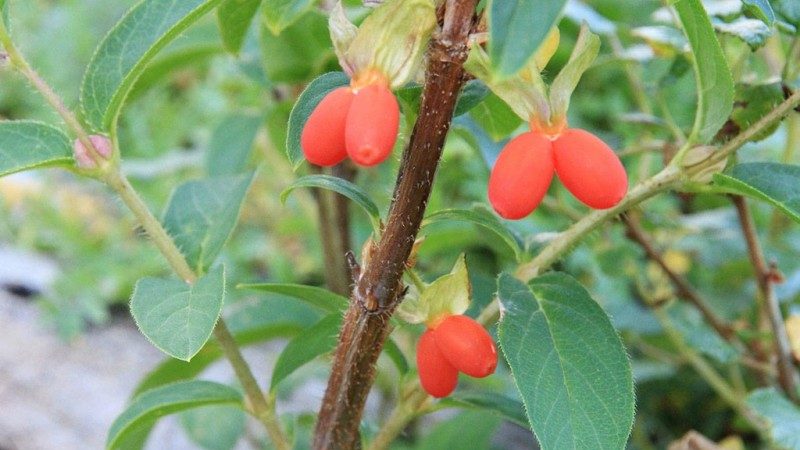
Of the inedible species and varieties of honeysuckle, the cap and wolf berries (common honeysuckle) are distinguished. The hat has decorative functions: a low-growing green shrub decorates the garden with original flowers and leaves. Wolfberry is found mainly in forests, its fruits are poisonous to humans.
Wolfberry
Honeysuckle is real or common, inedible or poisonous, depending on the variety. Such honeysuckle grows in forests or fields, mainly in the north and in central Russia. The leaves are opposite dark green elliptical. Flowers yellowish-white, appear in May – June. Fruits are dark red spherical, ripen at the end of July, are poisonous: they contain the glycoside xylosteine.
Wolf berries are a collective name for some plants: belladonna, crow's eye, real honeysuckle, wolfberry, and others.
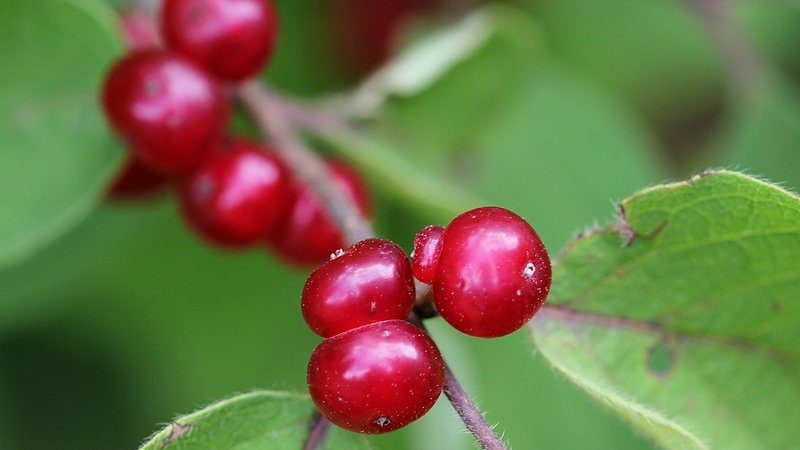
Pallas
This subspecies of blue honeysuckle grows in swampy and forested areas. Shrubs are undersized, shoots are thin and brown, green leaves are small. The berries are not suitable for fresh consumption, but after processing they are used in folk medicine.Honeysuckle contains organic acids and is rich in vitamin C.
Attention! At the beginning of ripening, some varieties of wolfberry can be easily confused with sea buckthorn. A characteristic feature of the first is that the fruits grow directly on the stem, tightly to each other. Sea buckthorn berries are arranged in a more chaotic order.
Hat
The cap honeysuckle has fragrant flowers, green glossy leaves of an ovoid or lanceolate shape. The fruits are spherical, depending on the variety, they become red, yellow or purple. The height of the shrubs is up to 1.3 m. The culture blooms in May – June, bears fruit in October.
Shiny Elegant
Evergreen shrub, undersized, no more than 0.5 m in height. The flowers are creamy white, the leaves are small dark green. Brilliant honeysuckle Elegant blooms in May, fruits are small, 4 mm in diameter. Culture grows on any soil, plant it in the sun or in partial shade. In cultivation, honeysuckle is unpretentious, summer residents plant it as a hedge.
Bedspread
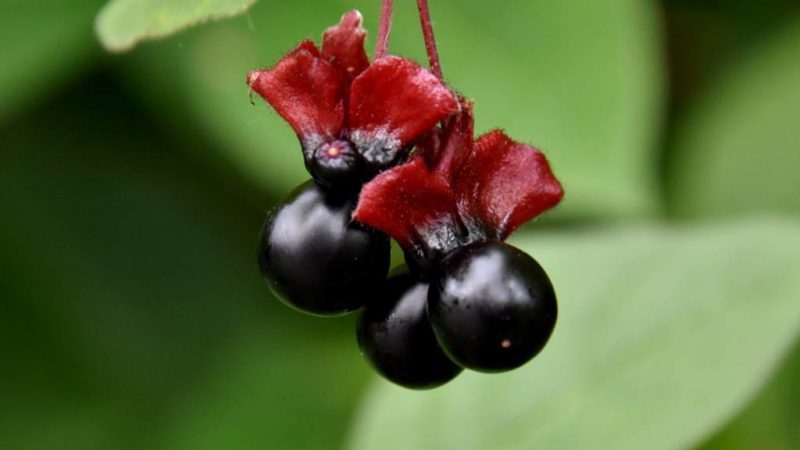
The height of the shrub is 2-3 m, the foliage is dense, the crown is wide. Honeysuckle blooms in May, the flowers are yellow, after a few weeks small black fruits appear. Bears fruit for 3 years after planting. Covering honeysuckle is shade-tolerant, but grows better in well-lit areas. It is planted alone or in several bushes at once - such plantings look spectacular on the site.
Henry
The height of the evergreen climbing shrub is 4–6 m, sometimes reaching 8 m. The leaves are ovoid-oblong green. The flowers are small, paired, yellow-red. The plant is shade-tolerant, blooms in May-June. Fruits are round and black, 3 mm in diameter. Henry's honeysuckle is suitable for cultivation in any region of the country, it is rarely damaged by pests. Shrubs are used in landscape design.
Read also:
Frost-resistant early ripe variety of honeysuckle "Lakomka"
Korolkova
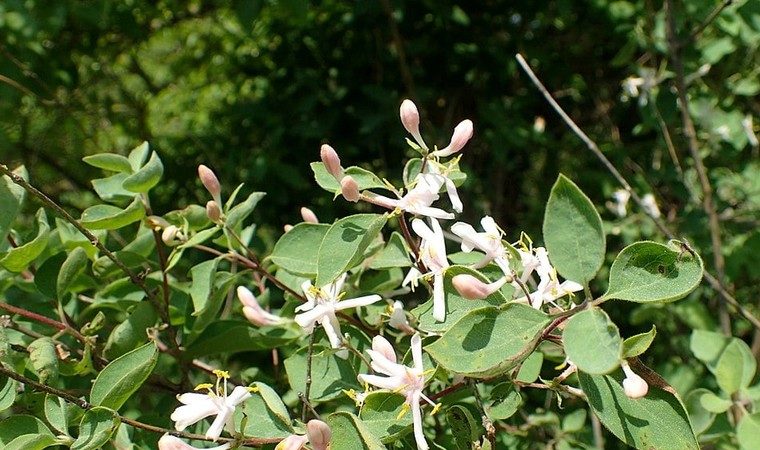
Korolkov's decorative honeysuckle is used for single and group plantings in dachas, in gardens and backyard plots. Height - up to 3 m, elliptical leaves, blue-green color with a bluish bloom. The flowers are pink and elegant. Fruits are spherical, orange-red. For planting, it is recommended to choose lighted places: in the shade, the plant blooms poorly.
Conclusion
Popular garden varieties edible honeysuckle - Zvezdochka, Pushkinskaya, Souvenir, to decorate the garden, nodding honeysuckle, common, Henry, Korolkov are grown. The plant is planted in open ground, having previously selected a place. Large areas are suitable for tall and spreading shrubs, small ones for compressed and compact ones.
Honeysuckle is unpretentious in care, does not require special growing conditions. Ripe fruits are suitable for any kind of processing: desserts, drinks, pastries are prepared from berries. It is one of the healthiest berries that contains vitamins C, P, B group, magnesium and sodium, pectins, tannins and anthocyanins.